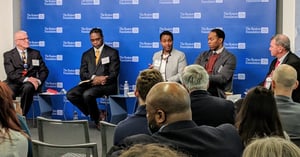 This week, the Boston Foundation released a sobering study that analyzed the state of STEM education in Boston’s elementary, middle, and high schools. “Getting It Right: Progress and Problems in Raising Science Achievement in Boston” looked closely at student achievement on the MCAS Science and Technology/Engineering tests and compared Boston’s students to those in the rest of the state in the grade-level mastery of science.
This week, the Boston Foundation released a sobering study that analyzed the state of STEM education in Boston’s elementary, middle, and high schools. “Getting It Right: Progress and Problems in Raising Science Achievement in Boston” looked closely at student achievement on the MCAS Science and Technology/Engineering tests and compared Boston’s students to those in the rest of the state in the grade-level mastery of science.
Simply put, in Boston, and across the state, MCAS Science and Technology/Engineering (Science) achievement in elementary school and middle school has historically been lower than achievement in MCAS English Language Arts (ELA) and Mathematics; it has improved less over time than ELA and Math; and has been markedly stagnant or declining since 2014.
No state understands the need for STEM education better than ours. Massachusetts continually ranks at the top for high-tech, biotech, and life sciences investments. Yet, the Commonwealth is one of only six states in the country without specific statewide high school science credit requirements. If we want to be a magnet for jobs and investment in these important sectors, our schools must become a pipeline that feeds talent into the STEM-driven marketplace—and one that does so for all students, including our most disadvantaged.
Higher achievement standards in science and technology for graduation should be the primary commitment to our students, helping them prepare for the 21st century workforce. And, while high schools across the state—including BPS—have seen significant increases in MCAS results in Science over the last decade, there are still tremendous opportunities for continued improvement by focusing efforts on the elementary and middle grades.
By the time many students reach high school, their interest, understanding, and desire to pursue STEM-related fields has waned. The reasons for this are manifold, but without the encouragement or the opportunities to explore the sciences deeply when they are young, most students will remain indifferent.
We know that introducing science education to even the youngest children works. The Museum of Science, in conjunction with the National Science Foundation, recently concluded a multi-year study evaluating the effectiveness of our own Engineering is Elementary curriculum. The study, which included 14,000 students in grades 3-5 from 604 classrooms in Maryland, Massachusetts, and North Carolina, reviewed the students’ mastery of a rigorous, hands-on, immersive engineering curriculum.
We found that the curriculum, supported by specific teacher training, can help all students – regardless of background, gender, or learning abilities – learn science and engineering better. As a result, what we see in the classroom are improved attitudes about and interests in engineering which can equip young students with tools they need to feel better prepared for college and careers.
Clearly, we know how to engage students in both ELA and math. Massachusetts public school students regularly rank first in the country in reading and math on the National Assessment of Educational Progress (NAEP) report card and first in the world in reading on the Program for International Student Assessment (PISA) test.
But our students did not become the best in those subjects by meeting minimal levels of expectation or by districts instituting cursory courses. They excel in math and ELA because we set rigorous achievement standards that dedicated educators work diligently to meet, build support systems around those standards and teachers, and begin working with students when they are young.
While there is opportunity for improvement, we have made significant inroads in the sciences. Seventeen years ago, I was part of a group of state education leaders who introduced engineering into the Massachusetts science and technology public school curriculum—making the Bay State first in the nation to develop and institute a K-12 statewide curriculum framework and assessments for technology/engineering.
Yet, as the “Getting it Right” report indicates, we still see achievement gaps in STEM fields here in the city, across economic, geographic, and race/ethnicity demographics. Until we put equal emphasis on high standards of achievement in the sciences—at all levels of schooling— as we do for math and ELA, we will not see improvements to these unsettling statistics.
It is up to all of us to introduce young people to technology and engineering, in both informal and formal educational settings, starting as early as the preschool years. It is time we treat science and technology education as equal in importance to math and ELA. We cannot wait until high school and hope to sway students after most have already determined that the sciences are not for them.
Children are natural born engineers and scientists. They are inquisitive, innovative, and find wonder in exploring possibilities. We must harness that curiosity—while providing support for teachers—so the learning environment is one in which science and engineering are part of the daily conversation for all students.








